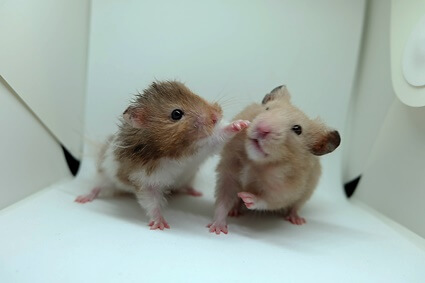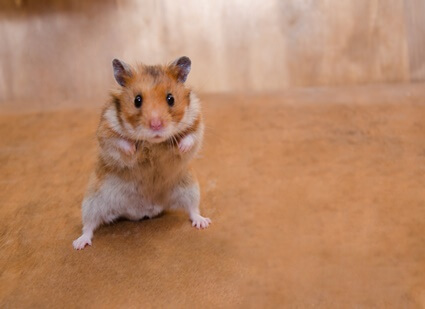When you look at hamsters’ fluffy fur, cute puffy cheeks, and little pointed ears, you’d be forgiven for thinking they’d never become aggressive and fight each other.
You’ve grown used to being lulled to sleep by the constant sound of the hamster wheel spinning at night. Aside from the wheel turning constantly, all is quiet in the hamster’s room.
Suddenly, you hear the angry hisses and squeaks of two hamsters in combat.
If you’re an owner of two or more Syrian or Chinese hamsters long enough, fighting will happen, as most species are loners. The only thing you can’t understand is why the hamsters are attacking each other.
Why Do Hamsters Fight with Each Other?
Here are the most common reasons why hamsters attack each other:
Unsociable Hamster Species
According to Developmental Psychobiology, as Syrian hamsters (also called golden hamsters or teddy bear hamsters) mature from juveniles to adults, they switch from playing to fighting.
When Syrian hamsters are young, they play fight frequently. As Syrians mature, they attack the flanks, lower belly, and rump. The play fighting turns to aggressiveness as adults, so keep them apart.
According to JSTOR, Chinese hamsters (also called Chinese striped hamsters or Chinese dwarf hamsters) shouldn’t be housed together because they fight for dominance.
Dwarf hamsters like to play fight, but it consists of chasing each other, wrestling, and rolling around together. If you notice any wounds or bleeding on dwarfs, their playing has become fighting.

Unfamiliarity
When two hamsters encounter each other for the first time, it can lead to fear, anxiety, and hostile behavior. To avoid conflict, introduce hamsters gradually so they can get used to each other’s scent.
Begin by putting the two cages next to each other. Then, exchange their bedding, toys, and food/water dishes. This enables the hamsters to familiarize themselves with each other’s scent without direct contact.
Once they’re comfortable, put them in a neutral environment, such as in a bathtub or hamster-safe room, and observe how they interact. If they seem happy, you can allow them to interact with each other.
Poor Socialization
Hamsters that aren’t exposed to other hamsters at a young age aren’t used to sharing territory and resources. They don’t know how to interact with members of their species, leading to conflict.
The Living Space is Too Small
If the hamsters have started fighting, it could be due to a lack of space in the enclosure.
Tempers are sure to flare when hamsters are crowded and don’t have room and resources. Hamsters are territorial, and a fight can erupt when another hamster enters their claimed space.
Hamsters that lack space and territory become highly stressed and anxious.
Opposite Sexes Living Together
It’s sensible to house compatible species of same-sex dwarf hamsters together, as having males and females together can lead to fights over mating.
According to the National Library of Medicine: National Center for Biotechnology Information, when hamsters approach sexual maturity, aggressive females may fight until dominance is established.
You also avoid the possibility of hamsters having unwanted babies, especially among siblings.
Feeling Threatened
Hamsters could start fighting if one of them feels threatened by another. This could happen if you have a more territorial or dominant hamster than the others.
A lack of food and water can lead to hamsters competing for the same resources. Consequently, they become aggressive to assert dominance. This is most likely to occur in overcrowded cages.
One hamster may claim something as theirs and fight with others who attempt to use or go near it.
Hierarchical Position
Two pet hamsters may fight to establish a dominant and submissive hierarchy. The dominant hamster will have access to the best food, toys, nesting areas, and other resources.
Hamster Body Language Signs of Fighting
If you monitor hamsters closely, they use body language to express their emotions.
Knowing which body language signs indicate fear, feeling threatened, stress, and anger can sometimes enable you to stop a fight before it happens.
Standing on Back Legs with Paws Up
A hamster that stands on its back legs shows you that something has made it feel threatened, and if that threat doesn’t go away fast, it may show hostility and aggression.
Ears Back with Eyes Narrowed
If you see a hamster with its ears laid back and eyes narrowed, it means it’s curious or suspicious. It hasn’t reached the point of feeling threatened, but it’s on high alert.
Rolls onto Its Back and Bares Its Teeth
The hamster feels threatened or scared and doesn’t want anyone to bother it.
Teeth Clacking
If the hamster clacks its teeth together, it’s a warning sign to stay away.
Moves Slowly Around the Edge of The Cage
A hamster slowly moving around the edge of its cage usually does so because something is happening in the cage that it’s unsure about.
Staying near the edge of the cage and moving slowly allows the hamster to monitor everything and puts it in the right position to attack or defend itself from harm.
Biting or Nipping
Hamsters biting at other hamsters are already aggravated, and their aggression is beginning. It may be a warning sign to the other hamster, but it’ll most likely lead to a fight.
Why Do Hamsters Fight To The Death?
Hamsters have been known to kill other hamsters. A hamster that has become aggressive may attack another hamster and inflict grievous wounds severe enough to cause death.
This extreme aggressiveness can occur if a hamster feels threatened, stressed out, limited in space, or just because they don’t like a particular hamster.
Even among the hamster species housed together, not all of them will get along. Maybe one hamster is louder, messier, or less considerate than the others.
Eventually, one of those hamsters will get fed up with these actions. Unfortunately, that fight could end in one of the hamsters dying from its injuries.

How Do Hamsters Kill Each Other?
A fight between hamsters may start with them chasing each other or with one nipping at or biting the other as a warning to discontinue a certain behavior.
The fighting will escalate to scratching, pinning each other down, and forceful bites. If the more aggressive hamster inflicts a severe bite wound, the other hamster could die shortly afterward.
Otherwise, it’s more likely that the seriously injured hamster will die slowly from its injuries after the other hamster has walked away satisfied with its victory.
Occasionally, hamsters may eat other hamsters. Female hamsters have been known to eat their young to ensure the survival of others in the horde.
For instance, if the food or water supply is particularly low, a female may kill one of her young so the other hamster pups will have sufficient food and hydration.
How Can I Stop My Hamsters from Fighting?
To stop hamsters from fighting, you need to narrow down the cause of the fighting. Things you can do to ease tension between hamsters include:
- Add new items: Different toys and items will be a good source of distraction.
- Hides: Make the cage more comfortable and private.
- Interaction: Spending time with hamsters can reduce aggression toward each other.
- Food and water: An ample food and water supply can reduce territorial behavior.
- Monitor the hamsters: Separate the hamsters at the first signs of hostility.
Same-sex Syrian hamsters might be able to live together if they were raised together. If not, keep them in different cages to avoid territoriality and aggression.
Normally, unless you have Campbell’s hamsters, Roborovski dwarf Hamsters, and winter whites, each hamster should be given a separate cage.





